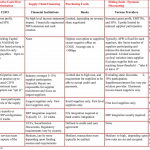
We considered factors such as live chat support, phone support, and comprehensive knowledge base resources to determine the level of support provided by each AI finance software vendor. On Vena, you can easily create budgets, models, and scenarios, as well as collaborate with team members through shared workspaces and workflows. Vena also offers a centralized data repository and automated data collection, reducing manual errors and ensuring data accuracy.
Planful: Best for Financial Planning and Analysis
Kavout uses machine learning and quantitative analysis to process huge sets of unstructured data and identify real-time patterns in financial markets. The K Score analyzes massive amounts of data, such as SEC filings and price patterns, then condenses the information into a numerical rank for stocks. An AI-powered search engine for the finance industry, AlphaSense serves clients like banks, investment firms and Fortune https://www.accountingcoaching.online/ 500 companies. The platform utilizes natural language processing to analyze keyword searches within filings, transcripts, research and news to discover changes and trends in financial markets. Ocrolus offers document processing software that combines machine learning with human verification. The software allows business, organizations and individuals to increase speed and accuracy when analyzing financial documents.
Benefits of AI in Finance

Not everyone needs to work with a human advisor, but doing so provides valuable insight and context you might not get with generative AI or even a robo-advisor. Estate planning, which involves drafting legally-binding documents to pass along your assets au section 722 interim financial information after you die, is one example of a complex situation that warrants speaking to a human advisor. While not a new concept, robo-advisors have become more sophisticated with the integration of AI, offering users a cheaper and more convenient way to invest.
Benefits from AI in your finance department
This compensation may impact how and where products appear on this site, including, for example, the order in which they may appear within the listing categories, except where prohibited by law for our mortgage, home equity and other home lending products. But this compensation does not influence the information we publish, or the reviews that you see on this site. We do not include the universe of companies or financial offers that may be available to you. Any estimates based on past performance do not a guarantee future performance, and prior to making any investment you should discuss your specific investment needs or seek advice from a qualified professional. AI bias refers to unjust discrimination in algorithmic decisions, stemming from inherent biases within the training data that mirror societal inequalities.
Beware, finance bros: AI is coming for banking before any other kinds of jobs, Citigroup warns
Sage Intacct is an AI-based finance management software that provides companies with real-time data and analytics to streamline and automate financial processes. It is specifically designed for small to medium-sized businesses and helps them manage their accounting, cash flow, budgeting, and other financial functions. Financial Services institutions are looking to AI to help them improve customer experience, grow revenue, and improve operational efficiency. Many banks have found that implementing AI requires financial investment and machine learning expertise and tools to fine-tune models on proprietary data to maximize their investments and achieve their goals. In this guide, we will identify several opportunities to apply AI in finance and how to get started so you can stay ahead of the competition.
The technology analyzes digital images and videos to create classification or high-level descriptions that can be used for decision-making. This technology allows users to extract or generate meaning and intent from text in a readable, stylistically natural, and grammatically correct form. Once companies start implementing AI initiatives, a mechanism for measuring and tracking the efficacy of each AI access method could be evaluated. Identifying the appropriate AI technology approach for a specific business process and then combining them could lead to better outcomes.
By leveraging large volumes of financial data, including historical market data, company financials, economic indicators, and news sentiment, models can help companies identify patterns, correlations, and trends that impact portfolio valuation. Financial institutions can also integrate alternative data sources such as satellite imagery, social media, and consumer behavior data into portfolio valuation models to enrich the analysis. Robo-advisors are gaining popularity as inflation rates soar, providing a simple and accessible option for passive investing. These automated wealth management platforms use AI to tailor portfolios to each customer’s disposable income, risk tolerance, and financial goals.
- With increasingly more capable machine learning models, robo-advisors can analyze more data and provide more personalized investment plans.
- Companies can also look at making best-in-class and respected internal services available to external clients for commercial use.
- Rather than turning to AI chatbots, there are other options available if you need personalized financial guidance, including traditional advisors and robo-advisors.
- While these advancements make money management more convenient and accessible, the advice they offer — if any — is often generic.
While large language models like OpenAI’s GPT-4 and Anthropic’s Claude work well out of the box, many financial institutions find that they need to customize models to get them to provide the best responses and align with their policies. Techniques like fine-tuning models on proprietary data, prompt engineering, and retrieval help elevate a base model from https://www.accountingcoaching.online/net-cash-per-share-meaning/ acceptable responses to a superior customer experience. Many financial institutions leverage their vast data to offer AI-enabled personalized service and guidance. Institutions can provide customers with assistant-like features, including categorizing expenditures, suggesting savings goals and strategies, and providing notice about upcoming transfers.
Combining many years of consulting experience in compliance and legal services with Aleph Alpha’s innovative generative AI technologies, the partnership operates under the name creance.ai. The aim is to develop innovative solutions using generative AI to support companies in dealing with complex legal and compliance requirements. Under pressure to reduce costs, gain efficiencies, and improve their customer experience, the majority of financial institutions clearly see beyond the hype of AI. Consumers are also getting more comfortable with the idea of AI-integration in financial planning.
Booke leverages AI to automate bookkeeping tasks, streamline data extraction from documents like invoices and bills, and improve client communication. It helps fix uncategorized transactions and coding errors and improves client communication. Booke.AI uses real-time optical character recognition (OCR) AI to extract data from invoices, bills, and receipts, accelerating transaction processing and saving time.
While exploring opportunities for deploying Al initiatives, companies should explore product and service expansion opportunities. This could be kick-started by measuring and tracking outcomes of AI initiatives to the company’s top line. Adding AI adoption to sales and performance targets and providing AI tools for sales and marketing personnel could also help in this direction. For scaling AI initiatives across business functions, building a governance structure and engaging the entire workforce is very important.

Without the right gen AI operating model in place, it is tough to incorporate enough structure and move quickly enough to generate enterprise-wide impact. To choose the operating model that works best, financial institutions need to address some important points, such as setting expectations for the gen AI team’s role and embedding flexibility into the model so it can adapt over time. That flexibility pertains to not only high-level organizational aspects of the operating model but also specific components such as funding. The advent of ERP systems allowed companies to centralize and standardize their financial functions. Early automation was rule-based, meaning as a transaction occurred or input was entered, it could be subject to a series of rules for handling. While these systems automate financial processes, they require significant manual maintenance, are slow to update, and lack the agility of today’s AI-based automation.
Financial institutions can enhance accuracy, efficiency, and decision-making with ai-powered asset valuation that is automated and accurate. These models can instantly consider factors such as historical market data, current market behavior, pricing models, proprietary research, and performance indicators. Valuing a portfolio is crucial for assessing its performance, making investment decisions, and reporting accurate financial information to stakeholders. However, manual valuation can be challenging as various factors influence portfolio value, including market data, pricing models, time horizon, and allocation of diverse investment types such as stocks, bonds, mutual funds, derivatives, and other securities. Financial institutions also leverage AI-powered copilots like Scale’s Enterprise Copilot to assist wealth managers internally. These copilots enable wealth managers to extract insights from internal and external documents, enabling informed decisions quickly and efficiently based on large volumes of data.
Comments